On October 14, 2020 the European Commission published its strategy for accelerating deep renovation of the existing building stock. The Renovation Wave is one of the main pillars of the European Green Deal towards de-carbonization of energy use for a cleaner environment.
Why a renovation wave?
The requirement for a renovation wave stems from the fact that the European building stock is not energy efficient while it is also responsible for almost 40% of the total energy use and 36% of the carbon emissions. This building stock that in its great majority will be standing for the next 30 years presents an opportunity for energy renovation interventions that will cause in positive impact on multiple levels. Apart from improved energy efficiency and reduced carbon emissions, energy renovation will tackle the energy poverty, will mobilize the construction sector and will contribute to cleaner, healthy, sustainable environment. This however cannot be achieved at todays’ very low rates. The Renovation Wave strategy aspires to double the annual energy renovation rates of buildings and furthermore promote deep energy renovations. The strategy will be supported by wider policy framework that has been set up for overcoming the barriers that impede its acceleration.
What does ReCO2ST offer?
The ReCO2ST project has developed a structured methodology for deep energy renovations that responds to the key principles of the Renovation Wave Strategy as demonstrated below:
Renovation Wave Key Principle 1 – Energy Efficiency Fist: One of ReCO2ST’s main advantages is the promotion of energy efficiency through upgrade of energy systems and installation of innovative energy-efficient technologies in order to achieve NZEB renovation. Within ReCO2ST project, innovative technologies including Vacuum Insulation Panels, Smart Windows, Cool materials, Cooling Evaporative Ventilated Façade and customized HVAC units have been developed and included in the renovation scenarios of the demonstrator buildings. ReCO2ST has set a target for final energy consumption to be <60% of the original. On the ReCO2ST renovation platform various technologies can be assessed and combined to build various renovation scenarios. The optimum scenario in terms of energy and cost is the one to be implemented. This connects energy efficiency to the second key principle: Affordability.
Renovation Wave Key Principle 2 – Affordability: Cost and time efficiency are also main advantages of ReCO2ST. The ReCO2ST methodology proposes a Least Cost Approach. On the ReCO2ST renovation platform, various renovation interventions in various combinations can be evaluated in terms of energy and cost efficiency, resulting in the cost optimal one. The Payback target set by ReCO2ST is <15 years.
Renovation Wave Key Principle 3 – Decarbonisation and integration of renewables: Renewable energy solutions are part of the ReCO2ST Retrofit Kit. Concentrating Photovoltaics (CPV) and CPV/Thermal have been developed within the project and included in the renovation package of two demonstrator buildings. On the ReCO2ST renovation Platform, renewable energy producing technologies can be evaluated and included as part of the solution in the customized renovation packages. The ReCO2ST target is for PV/Thermal to cover at least 40% of the annual heating consumption.
Renovation Wave Key Principle 4 – Life-cycle thinking and circularity: Apart from LCC, Life Cycle Analysis is one of the components of the ReCO2ST renovation platform. Overall the Environmental Impact Rating Target set by ReCO2ST is <60% of original (measured in CO2/m floor area)
Renovation Wave Key Principle 5 – High health and environmental standards: Attention to human health and comfort as well as to a clean healthy environment is part of the v advantages. The ReCO2ST targets to improve user satisfaction as well as reduce indoor pollutants. One of the solutions towards user health and comfort is the installation of Nature Based Technologies for air treatment as part of the renovation package. Installation of cool roof and paving materials will induce microclimate improvements, benefiting the immediate surrounding building area. Overall, ReCO2ST offers decarbonized renovation solutions that contribute to a cleaner and healthier environment both inside and outside.
Renovation Wave Key Principle 6 – Tackling the twin challenges of the green and digital transitions together: ReCO2ST proposes the installation of Intelligent Energy Management Systems for monitoring and managing the energy performance and indoor environmental conditions. An Intelligent Energy Management System (IEMS) that works as a supervisory controller has been developed within ReCO2ST. The IEMS optimizes trade-off between indoor air quality (IAQ), energy and comfort, adapting to climate conditions and user preferences.
Renovation Wave Key Principle 7 – Respect for aesthetics and architectural quality: The demonstrator building in Vevey speaks for this principle. A 1932 apartment building has been renovated with the ReCO2ST approach fully respecting its architectural identity while also enriching it inside and out to accommodate the selected renovation solutions. The ReCO2ST approach, is structured to assist the making process, but also flexible to allow the permissible interventions leading in a cost-optimal, NZEB, healthy renovation that respects the local environmental, social and cultural contact of the buildings and their surroundings.
The European ageing and energy inefficient residential building stock needs to be refurbished to achieve the energy efficiency targets and to secure healthy and comfortable living conditions. ReCO2ST project addresses the challenges of nZEB refurbishment through a systemic 3 step approach: firstly deploying a Refurbishment Assessment Tool to create refurbishment scenarios, empowering the decision making of the building owner, public or private; secondly forming Action Plans for the renovation through Integrated Project Delivery (IPD) and finally installing a refurbishment package of innovative and customizable technologies (Retrofit-Kit) for personalized renovation. One of the technologies of the Retrofit-Kit are vacuum insulation panels (VIPs). VIPs offer the best possible insulation performance on the market. They achieve a thermal conductivity of 0.007 W/(m∙K), which reduces significantly the required insulation thickness for a targeted U-value.
For example, to reduce the U-value of a wall from 0.53 W/(m²∙K) to 0.15 W/(m²∙K) only about 34mm thick VIP will be required against a 105 mm thick polyurethane foam layer; see Figure 1. This makes VIP the perfect insulation solution where limited space is available or if the available space is very valuable like in big cities.
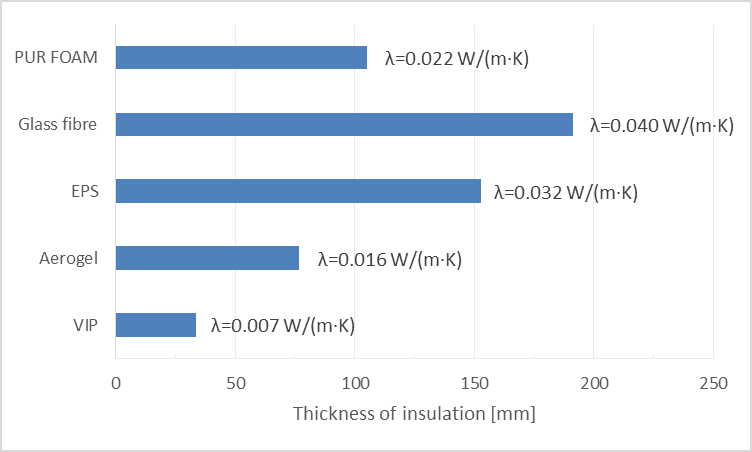
Figure 1: Required insulation thicknesses to improve the U-value from 0.53 W/(m²∙K) to 0.15 W/(m²∙K).
VIPs consist of a micro- and open- porous core material, which is wrapped into a dust protective fleece, evacuated and sealed into a high-barrier film (Figure 2). The high barrier film reduces the intake of air and water vapour, resulting in a service life of up to 50 years. Depending on the application, different core materials can be used, e.g. polyurethane, glass fiber or fumed silica. For long term applications, such as the construction sector, currently only fumed silica is suitable.

Figure 2: Composition of a vacuum insulation panel.
A new open porous polystyrene foam (Figure 3), introduced by the SUMTEQ, with tremendous potential for use in VIP has been investigated within the scope of ReCO2ST.
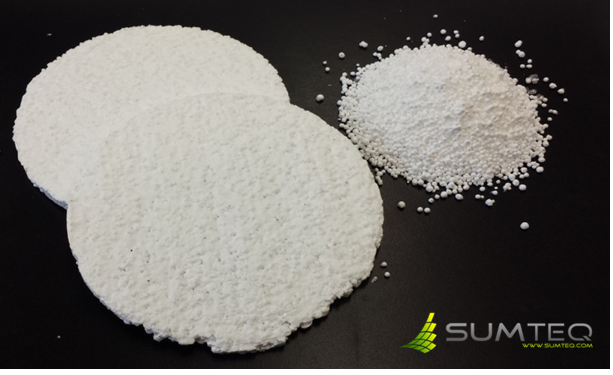
Figure 3: Foamed polymer granules and shaped parts.
Material was tested at Va-Q-Tec and Brunel University London to characterize and understand its suitability for VIPs. Besides evacuability, one relevant characteristic for the suitability as VIP core material is the dependency of thermal conductivity (λ) on gas pressure (p). Figure 4 shows this for different kinds of VIP core materials.
Glass fiber, used in a large proportion of VIPs currently produced, achieves the lowest thermal conductivity of all materials, of about 3 mW/(m∙K), at a gas pressures of 10-2 mbar. However, this material is very sensitive to an increase of gas pressure. This is notable by a strong increase by small increment in pressures, with an added contribution of “coupling effect”, which results in the end in a very high thermal conductivity of about 37 mW/(m∙K) at atmospheric pressure. Therefore, glass fiber is only suitable for VIPs which are required to perform over a very short useful life with vacuum retention capacity strongly depending on the properties of the high barrier film.
Open porous Polyurethane shows the highest value of thermal conductivity of 8 mW/(m∙K) at 10-2 mbar. However, it shows a huge increase in thermal conductivity by small changes of gas pressure. This material does not suffer from “coupling effect”, resulting in a thermal conductivity of about 34 mW/(m∙K) at atmospheric pressure. Like glass fibers, polyurethane cores are mostly used in short term, VIP solutions, such as ‘one-way’ transport containers.
Fumed silica on the other hand starts at about 4 mW/(m∙K) and maintains this thermal conductivity for a very long range of gas pressure. This is possible due to the nanometric pore structure of fumed silica, which is able to suppress air thermal conductivity in a larger range of gas pressure. This means that this material is the least sensitive of all materials discussed above, and therefore suitable for long term applications, such as building industry. At atmospheric pressure, the total thermal conductivity of fumed silica VIPs is 20 mW/(m∙K), even below that of still air (~26 mW/(m∙K) at 20°C.
The new developments of the polymer foam have been investigated for the dependence of thermal conductivity on pressure like the conventional VIP core materials. The new SUMTEQ foam was found, like fumed silica, to start with a thermal conductivity of about 4 mW/(m∙K) at low pressures. Its thermal conductivity increased stronger than that for fumed silica, but not as steeply as for the other two core materials. This behavior makes this new polymer foam suitable for the use in vacuum insulation panels. At atmospheric conditions, the foam reached a thermal conductivity of about 25 mW/(m∙K), which is still better than standard unevacuated EPS foam insulation.
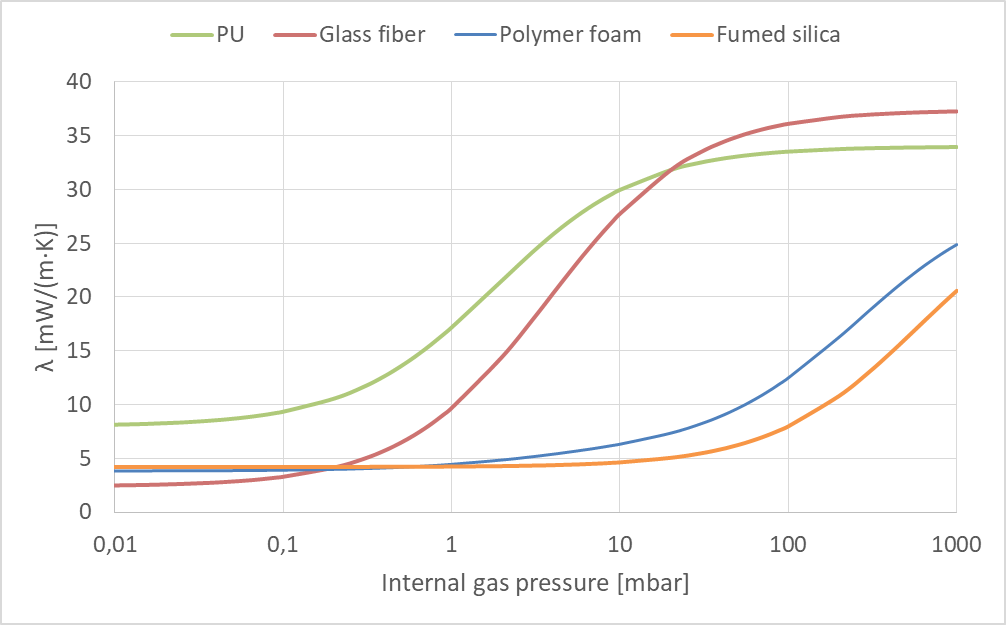
Figure 4: λ (p) for the newly developed polymer foam VIP in comparison to conventional VIP core materials.
Domestic hot water (DHW) is generally neglected in building refurbishment. However, DHW heat demand for office and school buildings could be reduced to almost zero by installing only to necessary points addressing only strictly necessary needs. In residential near zero energy buildings, DHW heat demand constitutes 1/3 to 1/2 of the total heat demand, as Figure 1 presents from Production efficace de l’eau chaude sanitaire Swiss Federal Office of Energy, OFEN (2017):
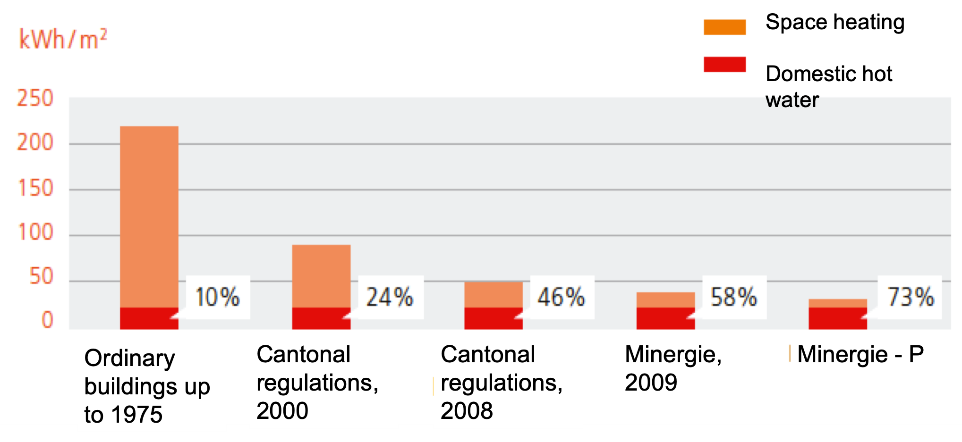
Figure 1: Heating energy demand in Swiss buildings
This case is a part of the ReCO2ST demonstration buildings. In the Swiss case study, particular attention to hot water production, storage, distribution and water needs, generated substantial energy savings. Monitoring before refurbishment showed very poor storage and distribution efficiency. 45% of the heat delivered to the hot water storage was lost before arriving to the tab. The heating cycles were too many, some dozens per day, with the heating system switching on and off very often.
The domestic hot water needs were almost 60 litres per person while according to “normal” conditions 50 litres were calculated for multifamily residential buildings. A multicriteria testing of shower heads in 12 families was performed, and a model was found to reduce water flow from a mean of 12 l/min before refurbishment, class D (varying between 8 and 25 l/min) to 6 l/min after refurbishment, class B. There was no push to get to class A, because if the water flow is too low and does not meet the tenant needs, they often change the shower heads by their own initiative and both objectives of energy savings and tenant satisfaction fail. Key qualitative criteria for tenant satisfaction is noise of the water jet and the ability of the jet to shower long hairs with foaming shampoo. The head shower with the highest score was selected. The shower heads and water taps were changed and a reduction of hot water consumption was achieved by 50 l/person after refurbishment.
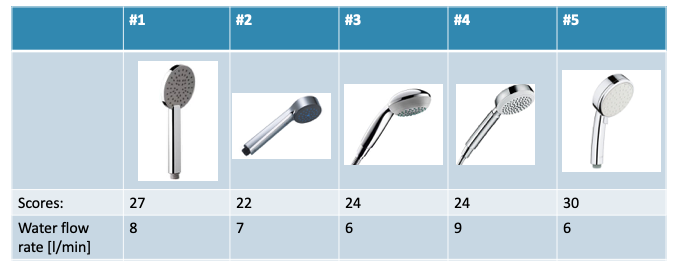
Figure 2: Shower heads tested
Pipe insulation, rising the on-off hysteresis of the heating cycles to 10°C (heating when hot water temperature is <45°C – stop heating when hot water temperature is >55°C, with one anti-legionellosis cycle per day at 60°C), insulation of hot water pipes and stopping hot water recirculation and reducing storage temperature to 45°C during the night, reduced significantly the storage and the distribution losses.
Hot water production of the Swiss case study is assured by almost 100% renewable district heating, so the question of the hot water production scenario was not pertinent for this case study. If this was not the case, applying the ReCO2ST least cost method it was found that after the renewable district heating production, the best scenario is production of 60% of the hot water needs with solar collectors (and not preheating DHW only covering 30% of the needs which is the current usual practice). The least cost method also showed that heat recovery on ventilation extraction for DHW preheating or heating is by far the most expensive solution and less energy efficient solution, even when the heat pump uses renewable electricity from the building solar roof.
For the demonstration building in Cádiz, an evaporative system has been designed to be installed on the roof. A series of partitions have been positioned above the traditional roof slab to create air channels, closed on its upper face by an insulating material (see Fig 2).
The technology developed in the ReCO2ST project is based on the ability to remove heat from the upper building floor due to the evaporative effect. With this objective, the complete design consists of:
The design procedure has several stages, using CFD method to study the air movement through the air channels and the design of the different layers of the roof composition.
Figure 1 shows a schematic drawing of the partitions’ position represented in red. The position of each partition, its length, and the separation between them has been optimized to reduce pressure drops and ensure a constant air velocity.
The 3 main elements of the construction detail (see figure 2) are from bottom to top: concrete slab, air channel and insulation material. It is very important that insulation is placed above the air channels so that cold air touches the surface of the concrete slab directly to extract heat. The insulation layer above the air channels prevents this air from heating in summer, and from cooling in winter.
The equipment takes air from the atmosphere; according to the thermodynamic cycle for which it is designed, (Maisotsenko cycle), experiences indirect cooling to a temperature that is between the wet-bulb temperature and the dew point without humidity increase. The cooled air is supplied through ducts to the roof, circulating between the air channels of the roof. By circulating between the roof channels, the air removes heat from the roof slab. Finally, the air is exhausted to the atmosphere.
Experiments show that this technology can decrease the temperature of the adjacent space on average up to 4°C, can decrease on average, reducing or even eliminating the need for air conditioning.

Fig 1. Schematic drawing of the position of the partitions.

Fig 2. Construction detail drawing.